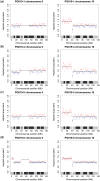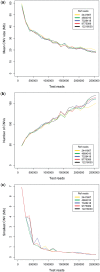Using next-generation sequencing for high resolution multiplex analysis of copy number variation from nanogram quantities of DNA from formalin-fixed paraffin-embedded specimens
- PMID: 20525786
- PMCID: PMC2919738
- DOI: 10.1093/nar/gkq510
Using next-generation sequencing for high resolution multiplex analysis of copy number variation from nanogram quantities of DNA from formalin-fixed paraffin-embedded specimens
Abstract
The use of next-generation sequencing technologies to produce genomic copy number data has recently been described. Most approaches, however, reply on optimal starting DNA, and are therefore unsuitable for the analysis of formalin-fixed paraffin-embedded (FFPE) samples, which largely precludes the analysis of many tumour series. We have sought to challenge the limits of this technique with regards to quality and quantity of starting material and the depth of sequencing required. We confirm that the technique can be used to interrogate DNA from cell lines, fresh frozen material and FFPE samples to assess copy number variation. We show that as little as 5 ng of DNA is needed to generate a copy number karyogram, and follow this up with data from a series of FFPE biopsies and surgical samples. We have used various levels of sample multiplexing to demonstrate the adjustable resolution of the methodology, depending on the number of samples and available resources. We also demonstrate reproducibility by use of replicate samples and comparison with microarray-based comparative genomic hybridization (aCGH) and digital PCR. This technique can be valuable in both the analysis of routine diagnostic samples and in examining large repositories of fixed archival material.
Figures







Similar articles
-
Targeted high throughput sequencing in clinical cancer settings: formaldehyde fixed-paraffin embedded (FFPE) tumor tissues, input amount and tumor heterogeneity.BMC Med Genomics. 2011 Sep 29;4:68. doi: 10.1186/1755-8794-4-68. BMC Med Genomics. 2011. PMID: 21958464 Free PMC article.
-
Genome-wide comparison of paired fresh frozen and formalin-fixed paraffin-embedded gliomas by custom BAC and oligonucleotide array comparative genomic hybridization: facilitating analysis of archival gliomas.Acta Neuropathol. 2011 Apr;121(4):529-43. doi: 10.1007/s00401-010-0773-z. Epub 2010 Nov 16. Acta Neuropathol. 2011. PMID: 21080181 Free PMC article.
-
Formalin Fixation, Delay to Fixation, and Time in Fixative Adversely Impact Copy Number Variation Analysis by aCGH.Biopreserv Biobank. 2023 Aug;21(4):407-416. doi: 10.1089/bio.2022.0036. Epub 2022 Sep 27. Biopreserv Biobank. 2023. PMID: 36169416 Free PMC article.
-
Making the most of pathological specimens: molecular diagnosis in formalin-fixed, paraffin embedded tissue.Curr Drug Targets. 2012 Nov;13(12):1475-87. doi: 10.2174/138945012803530125. Curr Drug Targets. 2012. PMID: 22974391 Review.
-
Evaluating statistical approaches to define clonal origin of tumours using bulk DNA sequencing: context is everything.Genome Biol. 2022 Feb 2;23(1):43. doi: 10.1186/s13059-022-02600-6. Genome Biol. 2022. PMID: 35109903 Free PMC article. Review.
Cited by
-
Identification of high-confidence somatic mutations in whole genome sequence of formalin-fixed breast cancer specimens.Nucleic Acids Res. 2012 Aug;40(14):e107. doi: 10.1093/nar/gks299. Epub 2012 Apr 6. Nucleic Acids Res. 2012. PMID: 22492626 Free PMC article.
-
Advances in understanding cancer genomes through second-generation sequencing.Nat Rev Genet. 2010 Oct;11(10):685-96. doi: 10.1038/nrg2841. Nat Rev Genet. 2010. PMID: 20847746 Review.
-
Whole-genome sequencing revealed an interstitial deletion encompassing OCRL and SMARCA1 gene in a patient with Lowe syndrome.Mol Genet Genomic Med. 2019 Sep;7(9):e876. doi: 10.1002/mgg3.876. Epub 2019 Aug 3. Mol Genet Genomic Med. 2019. PMID: 31376231 Free PMC article. Clinical Trial.
-
Copy-number variations observed in a Japanese population by BAC array CGH: summary of relatively rare CNVs.J Biomed Biotechnol. 2012;2012:789024. doi: 10.1155/2012/789024. Epub 2012 Jan 24. J Biomed Biotechnol. 2012. PMID: 22315515 Free PMC article.
-
Next generation sequencing and a new era of medicine.Gut. 2013 Jun;62(6):920-32. doi: 10.1136/gutjnl-2011-301935. Epub 2012 May 1. Gut. 2013. PMID: 22550129 Free PMC article. Review. No abstract available.
References
Publication types
MeSH terms
Substances
Grants and funding
LinkOut - more resources
Full Text Sources
Other Literature Sources
Miscellaneous

